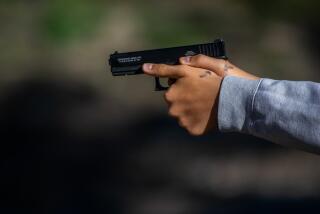In Defensive Maneuver, Parents Put Kids in Classes
- Share via
Even the 6-year-olds face the mock assailant--a male self-defense instructor in 40 pounds of protective body armor and a helmet--and prepare to physically defend themselves. The instructor might get a little aggressive, “actually acting like a bad guy, raising his voice,” said Perry Hauck, senior instructor for the Culver City branch of Impact Personal Safety, an international program.
“We scare them a little bit, and they get it that it’s something real ... though you don’t want to traumatize kids,” Hauck said.
These kids, though, are probably already aware of the recent spate of high-profile kidnappings, including the two teenage girls who were kidnapped at gunpoint in Antelope Valley on Thursday morning. The girls were rescued hours later. The media also have extensively covered the abduction of 5-year-old Samantha Runnion, who was snatched near her home in Stanton on July 15--kicking and screaming, the way her mother had taught her. Samantha’s body was found the next day.
Organizers of self-defense classes for children and teens say they are now being flooded with calls from parents who want their kids to learn verbal and physical tactics. Kids 6 and older practice one-on-one with a padded assailant, kicking, punching, yelling and using other tactics--similar to the ones taught to women in personal-safety courses. The physical skills are not meant to teach youngsters how to fight assailants, instructors said, but instead, to help kids get away and yell for help.
Though the National Center for Missing and Exploited Children recently urged families not to panic, saying abductions are “very rare,” parents still want their kids to know as much as possible about physically defending themselves, Hauck said.
At Impact Personal Safety, instructors want kids to learn while “highly adrenalized,” the way they would be in an actual assault. “In all of our classes, students strike the mock assailant full-force, including in the groin and head,” Hauck said. “It’s really important that students, whether they’re kids or women, have a sense of their own physical power.”
Some parents don’t believe there’s anything that their 6-year-old can do physically to protect themselves, said Lauren Hines, a self-defense instructor based in Los Angeles and Lake Arrowhead. But abductors typically “don’t want that hassle” of a kid who aggressively tries to get away with even simple tactics such as an eye gouge, she said. “The eye gouge is a very powerful strike. Not only is [the assailant] in unbelievable pain, but you’ve caused bleeding so he can’t see you.” In addition to physical training, the kids learn how to use their voices, set appropriate boundaries and other skills aimed at giving them self-confidence for problems they may be likely to experience, such as to ward off bullies, for instance.
Other programs make it a point not to scare kids. At Kidpower Teenpower Fullpower, a nationwide program, instructors teach “everyday safety skills,” said Janice Flynn, director of the Greater Los Angeles center, based in Granada Hills. “It’s nonthreatening. It’s not scary. It’s very matter of fact. It’s just like brushing our teeth. We never do anything scary.” The center emphasizes that kids should learn violence-prevention techniques from a very young age as a “set of life skills children should have along with everything else they’re taught.” Instructors work with children as young as age 4, but physical training is given only to those who are 7 and older.
On Saturday, the West San Gabriel branch of the Los Angeles Commission on Assaults Against Women held a free public self-defense course for kids in Pasadena. More than 110 kids signed up, and 70 or so more were put on a waiting list. The commission plans to offer another such course, possibly at the end of August, for kids 4 and older, said Denice Labertew , project director for the West San Gabriel office.
The commission, which is a nonprofit agency and rape crisis center, has offered a kids’ self-defense program for years, but when word got out about the free event, “we got an unbelievable number of parents calling, saying they desperately wanted their kids in this program,” Labertew said.
During the course, which focused on assertiveness and awareness training, 4- to 6-year-old kids also learned to punch and scratch, practicing on mannequin heads and kick bags. Older kids practiced evasive techniques with padded “assailants.”
“It’s not about being Superman,” Labertew emphasized. “You’re not trying to fight the evil-doer. What you’re trying to do is get yourself safe and ... run.”
In a separate room, parents met with safety instructors about how they could reinforce the training with kids at home without scaring them. “We ask that they don’t grab their children from behind and try to make it traumatizing,” she said, “but, ‘Show Mommy what [you would do] if something happened.’ ”
More to Read
Sign up for Essential California
The most important California stories and recommendations in your inbox every morning.
You may occasionally receive promotional content from the Los Angeles Times.










